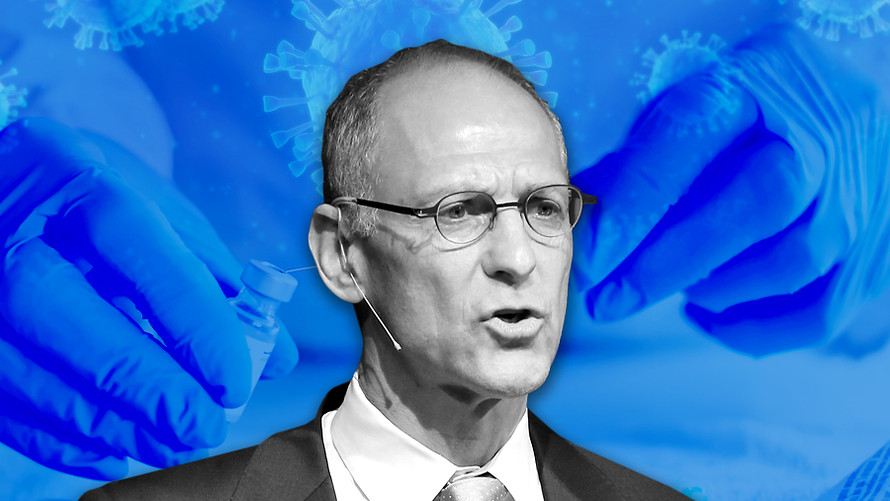
This interview is part of a series of conversations MarketWatch is conducting with some of the leading voices in the U.S. on the COVID-19 pandemic.
Even within one-party families, there is debate about how long it will take to get the U.S. out of the COVID-19 pandemic.
Dr. Ezekiel Emanuel, an oncologist, adviser to Democratic presidential candidate Joe Biden and vice provost for global initiatives at the University of Pennsylvania, says Americans have a tough 12 months ahead. On the other hand, his brother, Ari Emanuel, the Hollywood agent and CEO of entertainment agency Endeavor, predicts things will get better by July as long as a COVID-19 vaccine is authorized or approved in December.
“It’ll be closer to November, closer toward the end” of 2021, Zeke Emanuel told MarketWatch. “But it’ll probably be enough to begin opening colleges and universities [and] schools, again depending on how we distribute this thing and how effective we can be on that.”
For now, however, the focus is reducing transmission of the virus at a time when we are all starting to spend more time indoors and as pandemic fatigue is setting in. “There are four things that increase transmission: indoors, crowds, long periods of time, and then coughing, sneezing, singing [and] yelling,” he said. “If you put a group of people indoors, [and] one of whom is infected, it’s predictable what’s going to happen.”
MarketWatch: You published research that found the U.S. has had more deaths from COVID-19 than other countries and one of the highest per capita death rates worldwide. Why do you think we’re seeing this?
Dr. Zeke Emanuel: It’s a concatenation of problems. We never had an efficient testing regime so we could quickly identify people, isolate them and prevent spread. We didn’t have effective implementation uniformly across the country, with the public health measures: physical distancing, face-mask wearing, limiting crowds, which I think has gotten too little attention and needs more attention. If the main spread is by “superspreaders,” limiting crowds is critical to that. Hand hygiene. [At the beginning of the pandemic], we all focused on the fomites, the packages coming from Amazon and washing them down and all that nonsense. As it turns out, that’s probably totally irrelevant.
Then we had the problem of states saying, ‘Well, we don’t have it here,’ and not understanding epidemiology. You’ve got a small number of cases, but that means it’ll explode. We’ve seen that. Why is it all up and down the Midwest, whether it’s Wisconsin or Missouri or South Dakota or North Dakota? Because they were cavalier, saying: “We don’t have it here.” You have 500,000 people coming together for the Sturgis Motorcycle Rally. The president, frankly — there’s a lack of leadership and getting everyone together.
Coronavirus daily update:Trump lashes out at North Carolina rally over media focus on ongoing public health crisis
If you look at Taiwan or New Zealand, or even Italy, eight, 10, 12 weeks of really serious pain — limiting social activities, limiting groups — you get the number of new cases a day down to one per 100,000. In the United States, that means 3,000 new cases [or] 2,000 new cases a day, down from what we’re doing at 60,000. Then we can be a lot more free and open. The chance of spreading is low. Schools can open. Lots of things happen when you’re about 3,000 cases [a day], as opposed to 60,000 or 40,000 cases a day.
We just never had the staying power to do that. We wrote an op-ed in the Philadelphia Inquirer about the marshmallow experiment. [The marshmallow experiment was a study conducted in the early 1970s that tested the difference in children who opted for an immediate reward, compared with the children who were able to wait and get twice the reward.] Successful kids don’t eat the marshmallow right away. If America was a successful kid, we wouldn’t have rushed to open up four weeks after we see good results. We would have waited the full eight to 12 weeks to get down to low, low numbers nationwide. And that’s what we need to do.
MarketWatch: Were more stringent lockdowns the primary reason that countries like Taiwan and New Zealand have been able to manage the virus so much better? Or are there other factors?
Emanuel: It’s about bringing cases down in the initial lockdown. It’s then opening up and not rushing to open up indoor dining or indoor bars or gyms. [It’s] opening up outside, managing the cases, putting in place the testing routine, so that when you have an outbreak, you limit it very, very quickly. We’ve seen this capacity in South Korea and Taiwan. Wearing face masks limits the spread. Limiting the number of people together limits the spread. That doesn’t mean you can’t gather with people, but it’s a small number. Keeping your social network under 20 seems to be a critical threshold.
MarketWatch: That is interesting. Given the position that the U.S. is in now, how are you thinking about this fall and winter?
Emanuel: The biggest concern is we’re moving indoors. There are four things that increase transmission: indoors, crowds, long periods of time, and then coughing, sneezing, singing [and] yelling. And we’re going to move indoors, and many of the places we’re going in — houses, etc. — don’t have great air handling systems. If you put a group of people indoors, one of whom is infected, it’s predictable what’s going to happen. The last I looked, We’re at 220,000 [COVID-19 deaths] now. [The Centers for Disease Control and Prevention said Tuesday that more than 285,000 Americans have died than expected in 2020.]
MarketWatch: And we’re seeing the hospitalization numbers pick up right about now, as well. How concerned are you at this point about hospital capacity?
Emanuel: Nationally, it’s not a problem. It is a problem regionally, where you have places, like North Dakota and Wisconsin, that basically have no more beds. We saw this movie in New York, and it doesn’t play well. The end is: People die because you’re not able to get them the right attention when the hospital was overwhelmed. You have a lot of excess mortality then.
MarketWatch: What’s your viewpoint on the FDA guidance that came out recently around the extra monitoring period of two months? Is that enough of a safety measure?
Emanuel: It’s critical. Look, an effective vaccine is not a vaccine you can deploy. It has to be safe and effective. There’s a reason we put the word safety in there. It’s not just because it’s something that would be desirable but not necessary — it’s absolutely necessary. You’re going to give this vaccine to hundreds of millions, if not billions, of people, who are otherwise healthy and not suffering. It has to be safe. You can’t have a very high side-effect frequency. And, yes, we might end up with this efficacy signal before we have the full safety data. An effective vaccine that works but harms a lot of people is not a vaccine you are going to give to people and that people are going to take. We need both elements, and no reputable physician would approve a vaccine that’s effective and not safe.
MarketWatch: Do you think too much attention is being paid to the idea that a vaccine will be a quick fix to this pandemic?
Emanuel: Well, first of all, it can’t be a quick fix, because we can’t make enough of it fast enough and distribute it and administer it fast enough. The idea that we’ll have a vaccine at the end of December, and presto, change-o, everything changes. … Now, it will lead to changes, but that’s going to take months, actually.
The interruption [earlier in the interview, Emanuel asked to step away to take a separate call before returning to the call with MarketWatch] was an argument with my brother [Ari Emanuel] about when we get back to normal if we have a vaccine by the end of December. He’s like: “Well, six months. July 1.” Well, probably not.
MarketWatch: Makes sense. And especially once we start talking about widespread distribution of the vaccine.
Emanuel: It’s going to suck, even under optimal circumstances. The Operation Warp Speed people said that they’ll have 150 million doses. [The federal initiative has actually promised 300 million doses by January. Most of the vaccines in late-stage trials require two doses, with the exception of Johnson & Johnson’s JNJ, +0.79% COVID-19 vaccine candidate.] But by the way, 150 million people is not herd immunity. Herd immunity is going to require something like 220 million people. We’re not even going to have enough vaccine by then. And that doesn’t take into account the fact that it’s going to be a logistical challenge to get this out and administered properly.
MarketWatch: If July 1 isn’t your date, what is?
Emanuel: I think it’ll be closer to November [2021], closer toward the end of the year. But it’ll probably be enough to begin opening colleges and universities [and] schools, again depending on how we distribute this thing, and how effective we can be on that.
MarketWatch: One final question on your work with the Biden campaign. What do you think a Biden presidency would bring to addressing some of the big issues with the pandemic?
Emanuel: There are four major things. You’re going to change the tone around this. You’re going to have a president who actually models the public health interventions, with a mask, social distancing, not getting into crowds. You’re going to have experts giving you the briefings, not politicos. We’d have experts giving guidance, like the CDC will begin developing real guidance that it’s capable of, not the sort of light-handed guidance that we’ve gotten. You’re going to have someone or a committee that coordinates this thing, that has a subgroup on [personal protective equipment], a subgroup on testing, a subgroup on therapeutics, a subgroup on vaccines.
You’re going to have much more effective coordination with states so that they all have the same script that they’re working with and are not working at cross-purposes. But also importantly is you’re going to have evaluation and refinement. One thing I’ve experienced with Vice President Biden, when he ran the stimulus package under President Obama, was he was constantly evaluating. Is it having the impact? Do we need to change how we’re funding things? Is it really doing the job, rather than just shovel the money out the door and turn your back? He is this practical guy. Are we doing what we’re supposed to be doing? Are we getting to our goal?
This Q&A has been edited for clarity and length.
Read more A Word from the Experts interviews:
• Abbott exec: Why better COVID-19 tests may help the U.S. get back to normal









